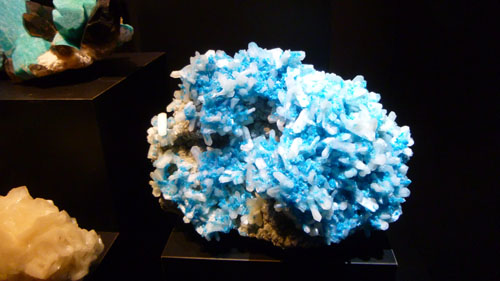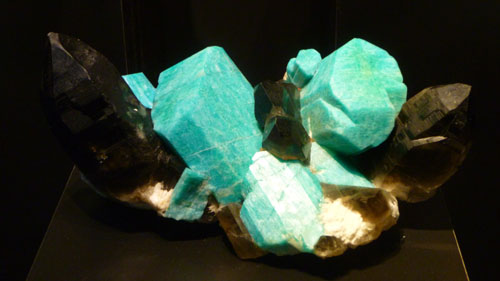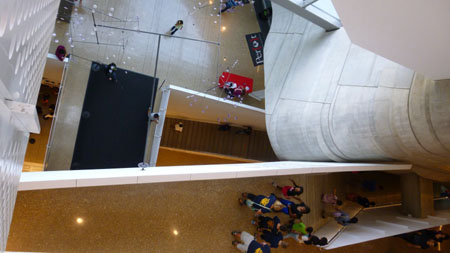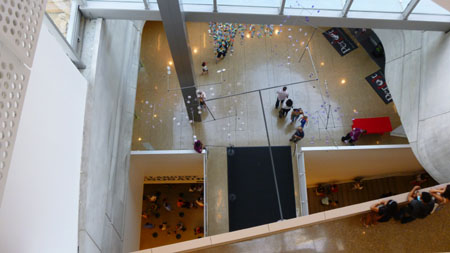

 |
Return to the page for Rudolf Lowenstein's Visit to Dallas |
 |
Return to the Index for 2014 |
Monday, July 27th, we quite hot, so we decided that today we would visit the Perot Museum with Rudolf, and save the Arboretum for tomorrow, when it was supposed to be a bit cooler.
Getting to the Perot Museum
|
So we head down Inwood to Lemmon Avenue, and hang a left heading southeast. At Oaklawn Avenue, we turn right, now heading southwest. This brings us to an entrance onto Harry Hines Boulevard, which we again take southeast.
Harry Hines goes past the KERA studios and then puts us right onto Field Street, the road that goes right in front of the museum. Rather than pay to park in the museum lot, we park the same place we park to go to Spaghetti Warehouse or the Aquarium. There are always meters available, and an afternoon's parking is only a buck or two- much less than the $12 cost for the museum lot.
The new Perot Museum of Nature and Science is situated at the southwest corner of N. Field Street and Woodall Rogers Expressway (the connector between I-35E and US 75 north on the west side of the center of Dallas).
|
We walked from the car underneath Woodall Rogers and across the street to the museum. The main way in is to work your way up the steps through a nice garden with some water features (you can see our path on the aerial view of the Museum at right) and then across the broad entry plaza and into the Education Building. This building contains classrooms, the gift shop, some offices and other auxiliary facilities. Once inside, you walk down a ramp to the lower level where the ticket and membership desks are located.
The Museum meters guest entry; tickets specify an entry time, and entry times are on the quarter hour. This is to ensure that the flow of visitors stays fairly steady. Once inside, visitors ascend a combination of escalators, ramps and stairs to the top level, from which point you work your way down floor by floor, exhibit by exhibit, and guests usually exit from the lowest level out to Field Street, or ground level down a long ramp back to the parking areas.
A Bit of History
|
On another timeline, the Dallas Children's Museum was founded in 1995 and served as a hands-on early childhood learning destination. By the early years of the millennium, there was considerable discussion about merging these various museums together- particularly since Fair Park, which had seen better days, was seeing declines in visitor numbers. Thanks to a $10-million gift from Hunt Petroleum group interested in this museum consolidation purchased 4.7 acres in Victory Park.
2006 was the watershed; in that year, three museums- the Dallas Museum of Natural History, The Science Place and the Dallas Children’s Museum- merged to create the Museum of Nature & Science at Fair Park. But the vision was to move the new museum to a more accessible location- Victory Park.
Fundraising went into high gear, and in 2008, T. Boone Pickens made a $10 million gift, quickly eclipsed when the five children of Ross and Margot Perot announced a $50-million gift in order to honor their parents by having the new museum named the Perot Museum of Nature and Science. And another $10 million donation financed the Tom Hunt Energy Hall.
|
The building is, indeed, an interesting one. It is basically a large cube with a signature protrusion on the east side (which enclosed part of the stairs from level 2 to level 4). The architect did take advantage of the Perot's siting some distance from any skyscraper to provide great views of downtown Dallas and the Victory Park area from various windows and balconies. On our way through the museum today, we took pictures from a few of these locations, and you can click on the thumbnail images below to have a look:
 |
Well, that's a bit about the history of the Perot Museum, so let's begin our visit. What I'll do is describe the various "halls" and exhibits that we visited- each in its own section.
The T. Boone Pickens "Life Then and Now" Hall
|
As with most museums, there were lots of display cases with rather more information than a casual visitor can quite absorb, so we read just what seemed interesting. Click on the thumbnail images below to see some of the pictures I took here:
 |
The exhibits on flight were very interesting; again, as with most museums, it would be nice to be able to take the time to see and read everything, but there is just too much. When you come around the main core into the fifth floor gallery, it is tough to pay much attention to the exhibits devoted to the abilities and evolution of flying animals when you can look out over the main floor of the hall and see the gigantic dinosaur skeletons on display. But we made the effort.
|
|
I also took a couple of pictures of these huge skeletons from the balcony, and you can click on the thumbnail images below to have a look at them:
 |
At the Field Street end of the balcony, we found a set of stairs leading down to the main exhibit areas. While we were descending these stairs, I paused to take a picture looking the length of the exhibit hall.
Towering dinosaurs, rare fossils and virtual paleo-habitats are just a few of the features that make the T. Boone Pickens Life Then and Now Hall a must-go destination for dinosaur lovers, fossil collectors or just about anyone who has ever wondered what life was like when dinosaurs roamed the Earth. Inside the 11,000-square-foot exhibition space on this floor, visitors can look at fossil finds like the infamous predator Tyrannosaurus rex or the plant-eating Alamosaurus. For those so inclined, there were stations at most of the exhibits where you could launch a video interview with the scientist who discovered the particular fossil skeleton. For kids, there were lots of exhibits about how plants and animals have adapted to changing conditions over the millennia.
|
 |
Other exhibits focused on how fossils are discovered, and particularly interesting were the displays that illustrated how scientists can deduce so much about the creatures and their adaptations using only information from the fossil discovery. Some exhibits talked about the advanced paleo methods and tools currently in use in the field and lab while others offered video footage of Perot Museum paleontologists at work. (Who knew the museum would already have its own paleontological staff?)
We all know that sea creatures eventually came out onto the land and, through an evolutionary process, became exclusively land-dwellers. I did not know that the process has worked in the reverse, but one particularly interesting exhibit talked about how a land-dwelling animal evolved into a giant marine predator called the Mosasaurus. There was a skeleton of a Mosasaurus on display, but I couldn't get back far enough to get the whole thing in, so I ended up taking three pictures of it. I wasn't careful about my angles, so when I stitched them together the result wasn't perfect, but perhaps it is good enough:
 |
There were other interesting exhibits about how the North Texas area was once under water, and how huge Ice-Age animals eventually went extinct. There was also what looked like an actual fossil lab, and kids could dress up in lab coats a few at a time and, in a simulation, I suppose, help the researchers.
|
Many of the exhibits had information I hadn't seen before- how ancient animals moved and ate and interacted with each other. Photographing the signage didn't seem to be a good strategy, but many of the skeletons were very interesting. Click on the thumbnail images below for some more pictures of them:
 |
Other interesting exhibits compared skeletal structures between meat and plant eaters, or explored predator-prey adaptations then and now, looked at ancient animal tracks and what they can tell us about family group structure and behavior (reminiscent of what you might find at Fossil Rim), and examined the winter survival strategies of modern mammals for clues that could explain how northern dinosaurs might have endured the cold as well.
The entire floor was full of interesting stuff, and we tried to see most of it. Click on the thumbnail images below to see the last group of pictures we took here in hall:
 |
The Lyda Hill Gems and Minerals Hall
|
With that introduction to the Hall, it’s easy to see what makes mineral crystals and gemstones so highly prized by collectors, jewelers and scientists alike. The Lyda Hill Hall uses high-definition videos, digital puzzles and touchable specimens to allow visitors to explore the astounding variety of colors, shapes and hardnesses of Earth’s original rock stars- from the gleaming luster of “fool’s gold” to the ultraviolet glow of fluorescent minerals.
|
The three of us worked our way around the large hall, having a look at all of the beautiful mineral specimens on display. Below, right, is one of the most beautiful specimens I saw, but all of them were challengers for "most beautiful."
 |
 |
One learns that different minerals possess a broad range of properties, and interactive exhibits bring this fact home via touchscreens, a hands-on touch table and visitor-controlled lighting.
|
To view the slideshow, just click on the image at left and I will open the slideshow in a new window. In the slideshow, you can use the little arrows in the lower corners of each image to move from one to the next, and the index numbers in the upper left of each image will tell you where you are in the series. When you are finished looking at the pictures, just close the popup window.
Other Areas of the Perot Museum
|
Below are clickable thumbnail images for a couple of pictures I took as we wandered through this Hall:
 |
As we went from floor to floor, using the stairs in the building's open air core, I did take a few pictures looking down into that core at the various levels below. Here are a couple of those pictures:
 |
 |
Leaving the Perot Museum
|
We happened to be on the lowest level of the museum, investigating some of the special exhibits- the ones that involve an additional fee. We weren't going to visit them, but we wanted to show Rudolf the whole building. We were near the lowest level emergency exit doors, where there is a kids' play area, and we had just stuck our heads inside when the high-intensity fire lights sprinkled throughout the building began flashing, and a raucous sound began blaring from the loudspeakers. Obviously, a fire alarm had been tripped somewhere, so we went back out into the hall near the exit doors, ready to exit the building, as a great many people began doing.
I became temporarily interested, though, in the automated fire doors that started coming out of the ceiling. What were these mechanisms that I'd not before seen in actual operation?
|
Anyway, as soon as the curtain started descending, the glass doors clicked open, and museum staff appeared, presumably to guide exiting visitors through them when the curtain blocked the center of the hall. I saw clearly what happened next, although there was no one to whom I could draw attention to the problem and, truth be told, not enough time to do so. Instead of descending smoothly, the curtain got hung up just above the light fixture, or possibly it didn't go into the slot through the fixture and got hung up on the fixture itself. But unlike a typical garage door that meets an obstruction, there was no safety mechanism to cause the curtain to rise again. It continued to be pushed downward until the pressure got so great that the light fixture gave way, the curtain smashed through it and then finally hung up again as the right side of the curtain missed the track between the two doors and the whole thing stopped.
It was startling when the light fixture gave way, and large pieces of the half-inch thick Plexiglass showered down on the museum visitors still making their way to the exit doors behind me. A number of visitors were hit by the falling pieces, although I did not see anyone actually hurt. There were the usual screams of surprise and parents shielding children from falling debris, and after the hubbub died down, I took one more picture.
|
In this picture you can also better discern the breaks in the light fixture- like the one near me. There was another such gap where the curtain was supposed to go, but didn't. After taking this picture, I took one more look around and then joined Rudolf and Fred who had already exited the building.
So our visit to the Perot Museum of Nature and Science ended with a bang- literally.
You can use the links below to continue to another photo album page.
 |
Return to the page for Rudolf Lowenstein's Visit to Dallas |
 |
Return to the Index for 2014 |